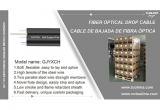
The Optical Cable Market Is Evolving
Over the past few years, the global fiber optic industry has been flooded with buzzwords such as “invisible cable” and “transparent fiber.” These products are often showcased for their elegant design and easy indoor installation, especially in FTTH (Fiber-to-the-Home) projects.
However, behind the growing popularity of transparent fiber lies a key question: how does it differ from bare fiber, and which type should professional installers or telecom operators choose for different applications?
In this article, we’ ll take a deep look at the technical structure, application scope, and performance comparison between transparent fiber and bare fiber, helping buyers and engineers make informed decisions when designing or expanding their fiber networks.
Understanding the Core Difference: Structure and Coating
At a glance, both transparent fiber and bare fiber share the same optical core — a glass or plastic strand that transmits light signals. The key difference lies in their outer protection.
l Transparent Fiber (Invisible Fiber)
Structure: Core + cladding + ultra-clear coating.
Material: Usually PMMA or fluoropolymer coating with a low refractive index.
Diameter: Around 1–2 mm, slightly thicker than bare fiber for mechanical protection.
Feature: Coating remains optically clear, allowing the fiber to “disappear” visually on walls or furniture surfaces.
Typical Use: Indoor decoration, FTTR (Fiber-to-the-Room) projects, smart homes, and office aesthetic cabling.
l Bare Fiber
Structure: Only core and cladding, no protective buffer or jacket.
Diameter: 125 µm (standard).
Feature: Extremely fragile, designed for fusion splicing, lab testing, and temporary connections.
Typical Use: Testing, connector assembly, optical experiments, or short internal jumper repairs.
In short: Transparent fiber is designed for aesthetic deployment; Bare fiber is designed for technical processing.
Performance Comparison: A Battle Between Practicality and Beauty
.png)
From this comparison, it becomes clear that transparent fiber is an evolution of design convenience, while bare fiber remains a technical necessity for manufacturing and maintenance.
Application Scenarios: Where Each Fiber Truly Belongs
u Transparent Fiber: The Choice for Visual Harmony
In luxury residences, museums, hotels, and smart home systems, transparent fiber allows installers to hide fiber routes seamlessly along walls or ceilings.
It enables aesthetic integration without bulky conduits — ideal for FTTR, indoor lighting control, and IoT device connections.
But its limitations are clear: it’ s not UV-resistant, not waterproof, and has limited tensile strength, which makes it unsuitable for outdoor or industrial applications.
u Bare Fiber: The Backbone of Fiber Engineering
Every outdoor optical cable, from ADSS cable to duct cable, begins its journey as bare fiber.
These fibers are precisely coated, colored, and reinforced during production to become the heart of the optical cable.
For field engineers, bare fiber is the material they splice and connect — it’ s not for deployment, but for integration and testing.
In essence, transparent fiber serves users, while bare fiber serves engineers.
Cost, Reliability, and Market Perception
Transparent fiber cables have grown popular among home users and interior designers, but professionals in the telecom and broadband industry are cautious.
While aesthetics drive curiosity, most B2B buyers still prioritize:
-- signal attenuation,
-- temperature endurance,
-- installation lifespan,
-- compatibility with existing network systems.
That’ s why major optical cable suppliers continue to focus on ADSS outdoor cables, loose tube cables, and distribution cables, which ensure long-term network stability.
The Buyer’ s Perspective: What’ s the Real Value?
When choosing between transparent and bare fiber, buyers should consider the purpose rather than the trend.
- Choose Transparent Fiber if:
You’re installing fiber in visible indoor environments (homes, showrooms, retail spaces).
You need lightweight, low-voltage indoor solutions.
The project emphasizes visual aesthetics.
- Choose Bare Fiber (or Protected Optical Cables) if:
You’ re building telecom networks, FTTH infrastructure, or industrial cabling systems.
You need reliable data transmission and environmental protection.
Your project involves splicing, fusion, or outdoor routing.
From Trend to Technology: The Future of Optical Aesthetics
Transparent fiber represents a new movement — the fusion of technology and design.
In the future, we might see hybrid models: semi-transparent fibers with UV-protected coatings, enabling both beauty and durability.
However, professionals should remain cautious: a fiber’ s optical performance and stability always outweigh short-term visual trends.
At TUOLIMA, we believe that innovation and reliability must go hand in hand. With over 20 years of fiber manufacturing experience, we continue to supply high-performance outdoor fiber optic cables, ADSS cables, and accessories that meet international standards for stability, longevity, and safety.
Final Thoughts
Transparent fibers and bare fibers may look similar under a microscope, but their purposes, strengths, and markets are entirely different.
If transparent fiber stands for” design innovation,” then bare fiber represents” engineering truth.”
And in a world driven by digital connectivity, both have their stage — as long as we understand where the real boundary lies.
Related Products
IP68 Fiber Optic Splice Closures — Designed to provide secure and reliable protection for fiber optic joints
Aug 02-2024

Enhancing Campus Connectivity: GJYXCH Fiber Optic Cable in Educational Networks
Jan 09-2024

Elevating Urban Infrastructure: GJYXCH Fiber Optic Cable in Smart City Networks
Jan 07-2024